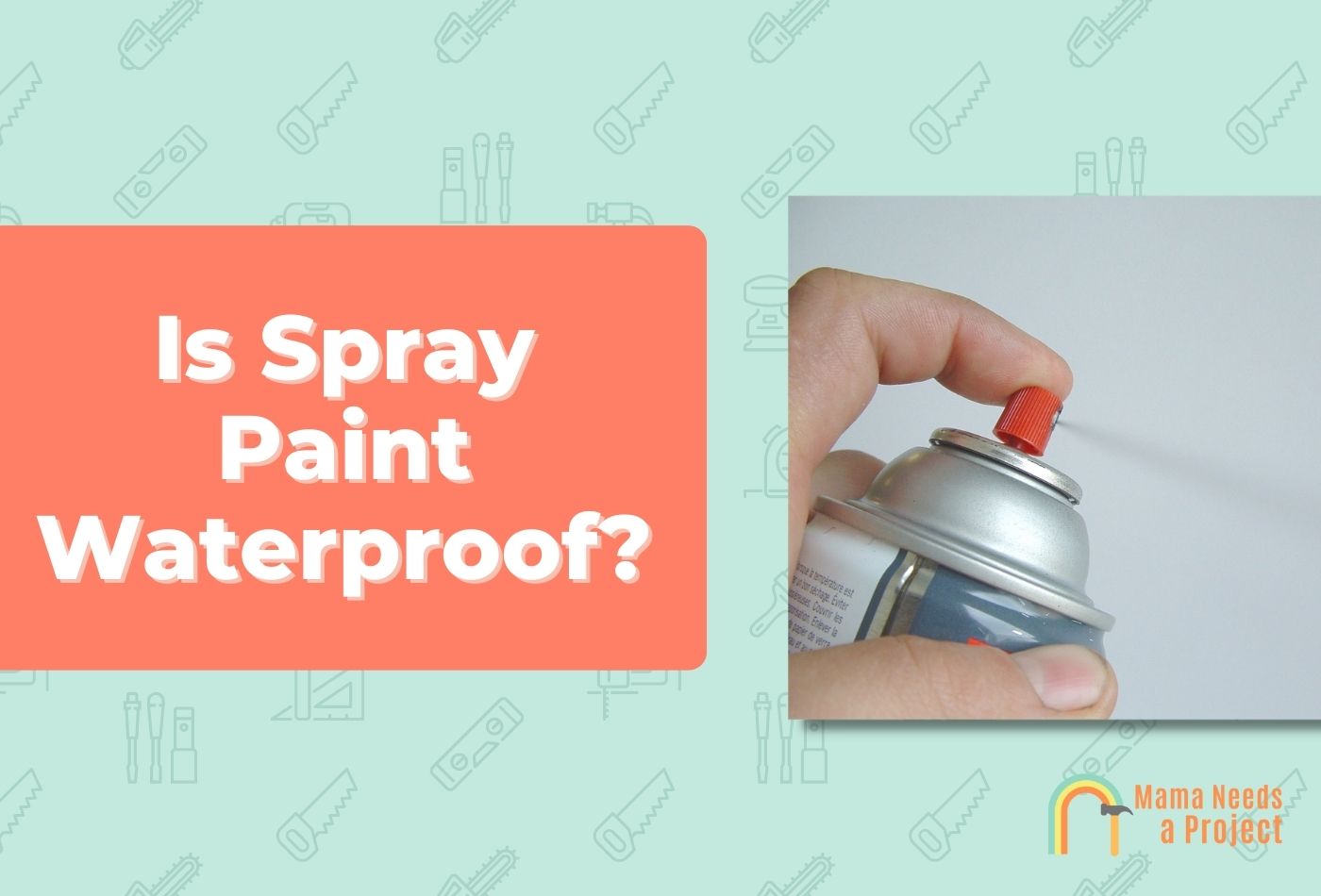Is Spray Paint Waterproof? (What You Should Know!)
Spray paint is a super convenient way to give a new life to your projects. Whether you’re painting outdoor furniture or updating some light fixtures – spray paint is one of the most versatile paints you can find.
But is spray paint waterproof? The short answer is yes, but not all of the time. So how do you know which spray paint is waterproof? In this guide, I’ll uncover all of the details so you can decide which paint to use on your projects! Let’s dig in!
- Some spray paints are waterproof but most aren’t. Most spray paints are water-resistant, meaning they can withstand some moisture exposure but not endless exposure.
- Waterproof spray paints include emulsifiers that boost bonding capacity, so moisture won’t be able to penetrate the paint once it bonds to the surface blow, whether it’s wood, metal, or another material.
Is Spray Paint Waterproof?
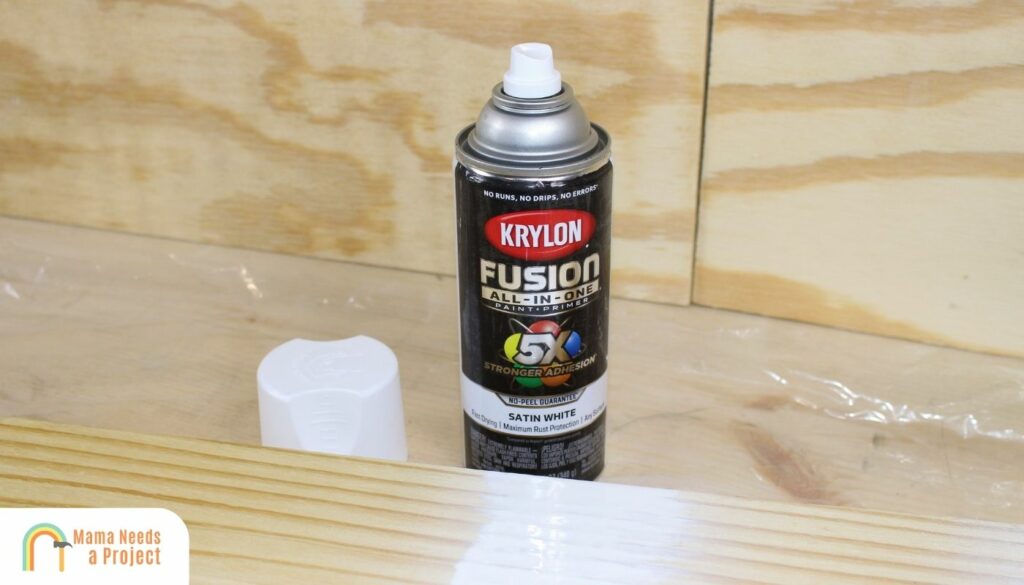
When you consider all the spray paint products on the market today, only a small minority are 100% waterproof.
Most spray paints are water-resistant, and some offer no water resistance whatsoever.
The vast majority of commercial-grade spray paints—like those used on cars and certain building exteriors—are 100% waterproof, and you can find some products intended for DIY outdoor projects that are waterproof as well.
Most waterproof spray paints are designed to be sprayed out of a high-grade sprayer; it’s rare to find waterproof spray paint in a can but these products do exist.
If you need a 100% waterproof paint, be sure to check the label of your paint for the exact specs.
Spray painting wood can be a great way to add some color to your projects. Find a color that suits your project and get to work!
Waterproof vs Water-Resistant
It’s important to distinguish “waterproof” from “water-resistant” before moving forward.
A product that’s waterproof will not be compromised by water, even if it’s subjected to a large volume for extremely long period.
Something that’s water-resistant, on the other hand, will hold up well against water, but it will break down gradually every time it’s exposed to water or moisture.
So a surface that’s waterproof isn’t going to be adversely affected by humidity, whereas something that’s water-resistant will be.
Spray paints that are engineered to be waterproof include certain additives, otherwise known as emulsifiers, and these essentially reinforce the spray paint so water can’t penetrate it and break it down.
But you must apply waterproof spray paint carefully, or else it won’t form a 100% protective seal across the entire surface—more on that later.
How to Know if Spray Paint is Waterproof
When selecting spray paint, to know whether or not a spray paint is waterproof, simply look at the ingredients/components list on the container to see if the additives mentioned above are included. But this is more of a last resort.
Most waterproof paints clearly indicate the presence of this quality in bold, colorful letters on their containers.
After all, being waterproof is a distinguishing quality that must be highlighted when marketing, something all spray paint manufacturers know.
Paints that aren’t waterproof usually indicate they’re water-resistant somewhere on the container.
Since there are so many types of spray paints on the market these days, it’s best to skip products you’re unsure of and go with ones that make it clear they’re completely waterproof and designed for both interior and exterior applications.
Wondering if spray paint is food safe? Check out my guide to learn more!
Can Regular Spray Paint Be Waterproofed?
Regular paint can be made waterproof paint by adding the necessary emulsifiers, but this isn’t done often because adding emulsifiers to a paint that wasn’t designed to be waterproof doesn’t always guarantee the results you’d get from a spray paint that was designed for this purpose.
Essentially, if you don’t put in enough additives, or if you don’t mix them well, the paint may not be as reinforced as it should be, and therefore it won’t be able to prevent moisture-related wear.
And if you put in too many additives, this could negatively affect the paint in other ways. Specifically, this may cause discoloration or a change in consistency.
Overall, it’s better to just find a waterproof spray paint or outdoor spray paint instead of trying to DIY it.
Best Waterproof Spray Paint for Wood
Best Waterproof Spray Paint Overall
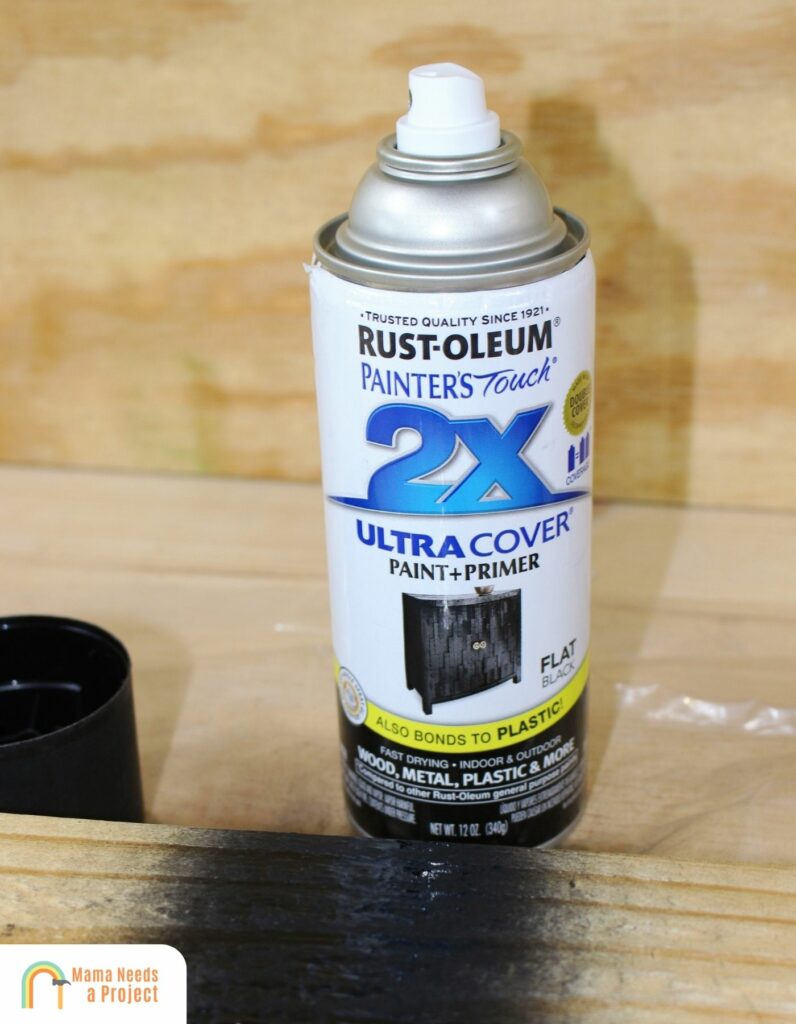
- Ideal for use on interior/exterior surfaces including wood, plastic, plaster, metal, masonry and unglazed…
- Oil-based formula is low odor, resist chips and provides long-lasting protection
- Dries to touch in 20 minutes and covers up to 12 sq. ft. per can
Rust-Oleum 316292 Painter’s Touch 2X Ultra Cover Spray Paint is the best sprayable paint in a can because it’s easy to use and durable.
It also smooths itself out while drying, and it dries quicker than competing products of similar quality.
You can use it on wood, plastic, metal, and wicker, and it can cover a wide areas while ensuring rich color throughout.
This can is ideal for furniture and craft projects, and to use it all you have to do is hold it 10-16″ away from the workpiece’s surface and spray.
Just make sure you shake the can beforehand. If it clogs, all you need to do is twist off the top and clean it out with mineral spirits.
Since the can is small and easy to maneuver, you can get at those hard-to-reach places. Plus, thanks to the comfortable tip, you can spray for a long time without experiencing finger fatigue.
Best Outdoor Waterproof Paint
- Rain ready in 1 hour
- Spray any way tip
- Fade, crack and peel resistant
Krylon Outdoor Décor Spray Paint is the best spray paint for outdoor applications because it dries quickly and withstands the elements even after many years have passed.
In addition to being waterproof, it’s also highly UV-resistant, so it’s often used on surfaces that can’t escape the sun’s rays.
Even though it’ll be “rain-ready” in less than an hour after application, you shouldn’t apply this spray paint outdoors in the rain, for it won’t dry properly if you do.
There are 12 fluid ounces of paint in the can and it has a satin sheen.
Krylon spray paints can be applied to wood, plastic, ceramic, and metal surfaces, and because of its easy-to-adjust tip this spray paint can will hit even hard-to-reach exterior surfaces.
Best White Waterproof Paint
- Ideal for use on ferrous, non-ferrous metal, wood, concrete, masonry and other such surfaces to provide rust…
- High quality, durable oil-based formula maintains consistent, corrosion-resistant color despite the elements
- Covers up to 14 sq ft, dries to touch in 15 minutes and recoats within an hour for quick project completion
Being waterproof is especially important for white spray paints, since a variety of elements can discolor these paints, like dirt, rust, mold, mildew, and UV rays.
Rust-Oleum 7590838 is the best waterproof spray paint for wood because it’s oil-based and formulated to be extra-tough yet it’s visually striking, so it’s great for a range of commercial applications.
This spray paint can be used on concrete, wood, metal and plastic surfaces, so it’s ideal for all kinds of indoor and outdoor projects.
You get 15 fluid ounces of paint in this can, which is a bit more than others.
How to Prep Wood for Spray Paint
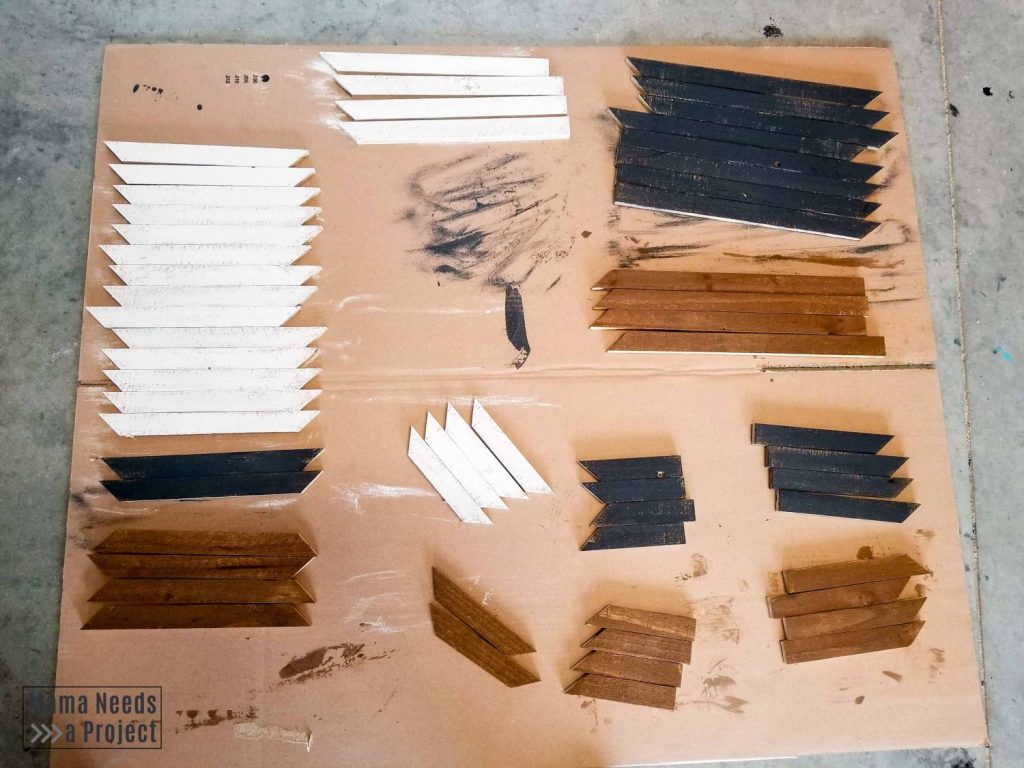
1. Gather Your Materials
Before you start spraying your workpiece, you need to gather all the necessary materials. Gathering all the materials before you start means you don’t have to interrupt the process at some point to get an item you don’t have.
The following materials are necessary if you want to spray on waterproof spray paint:
- Sandpaper
- Mineral spirits (or dish detergent with warm water)
- Cleaning sponges
- Tack cloths
- Primer
You’ll also need a couple tarps: one for the ground under the workpiece and one that can be set up behind the workpiece so you can block spray that doesn’t hit the workpiece. It’s best to have an easel since a tarp can be easily draped over this.
Some say you can use an orbital sander before applying spray paint, but I’ve found this power tool takes off too much material.
Therefore, I usually go for just sandpaper or sandpaper with a sanding block. Sanding by hand creates less dust, meaning there’s less mess later.
2. Prep the Work Area
Once you have all the materials you’ll need, it’s time to set up your work area.
For other kinds of painting projects, I wouldn’t devote a whole sub-section to work area prep, but in this case it’s necessary because you’re going to be spraying paint, and if you’re not careful you could spray it all over your workbench or other surfaces you don’t want to paint on.
I’ve already discussed the tarp-and-easel setup, so now it’s time to take about proper ventilation.
You should run a floor, desk, or a ceiling fan and open at least two windows; this is to ensure you don’t get overwhelmed by the fumes.
Of course, you’ll have all the necessary safety gear on, but it’s better to be safe than sorry.
Don’t have the fans blowing too powerfully and don’t open the windows too much; a breeze could carry the paint away from the workpiece and tarps, causing it to land on a surface you don’t want touched.
Check out this Rustoleum vs Krylon comparison to find out which spray paints are best!
3. Prep the Workpiece (Clean, Sand & Prime)
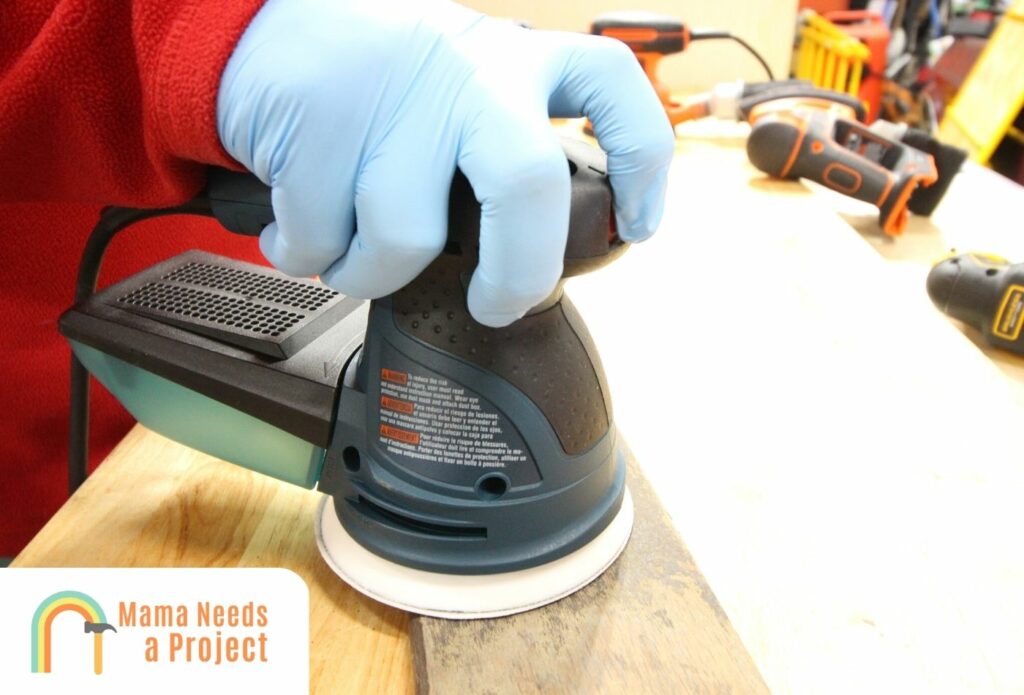
After you’re done prepping your work area, it’s time to prep the workpiece.
The first thing you should do is clean its surface with mineral spirits or dish soap and warm water.
Cleaning will remove any dirt, stains, or grease that’s on the surface.
After cleaning, let the workpiece dry for an hour or so.
Now it’s time to sand. Grab a piece of fine-grit sandpaper so you can rough up the surface.
Sand lightly so you don’t take off too much material; your goal should be to scuff the surface so the spray paint can adhere better.
Once you’re done sanding, wipe off the surface with a tack cloth; you can go over it with a vacuum first if you don’t want to wipe off a ton of dust.
Now it’s time to apply primer. Technically this isn’t necessary, but since it helps the paint stick and there are no glaring downsides, applying primer before spray paint is a good move.
How to Apply Waterproof Spray Paint
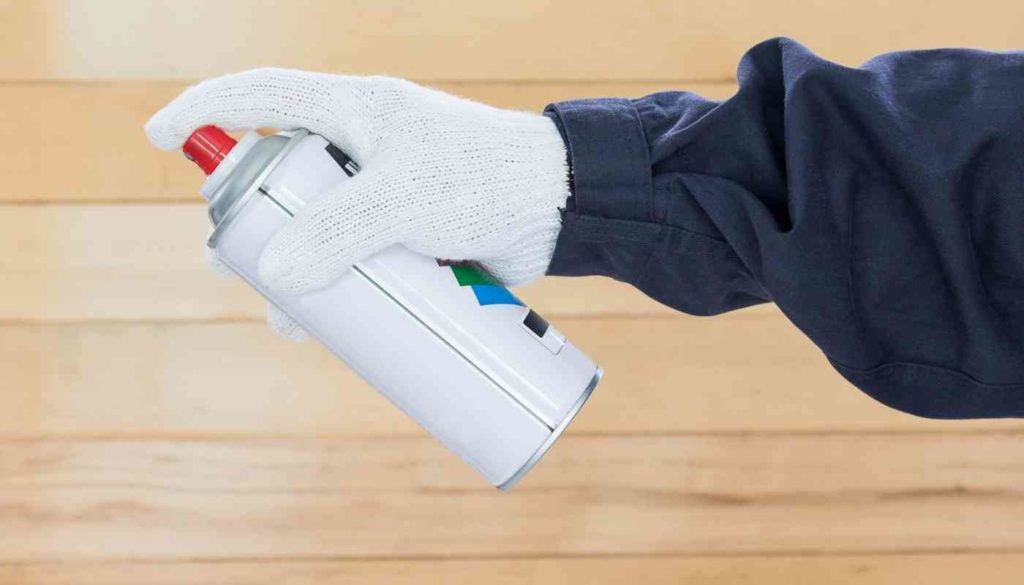
1. Get Ready to Spray
When the workpiece is ready to go, put on all necessary protective equipment so you’re shielded from the VOC when spraying paint.
If you’re using a spray can, simply shake it up to prime it for spraying.
If you’re using a sprayer, you’ll need to load it with the waterproof spray paint you’ve selected.
To ensure sections of the workpiece you don’t want painted remain paint-free, use painter’s tape.
2. Start Spraying
When applying paint with a sprayer or spray can, you need to be constantly moving your arm, since stopping while spraying could cause you to apply too much paint in one spot.
A horizontal surface is the easiest kind to spray, but if you have to spray a vertical surface it’s best to do so slowly; this way you can eliminate drips as they appear.
I can’t emphasize enough the importance of spraying in a continuous, flowing motion; think of how a conductor moves their hands to lead an orchestra.
Don’t spray right up close to the surface, and don’t be so far back that most of the spray falls short; being a few feet away should yield the best results.
Also, once you start spraying, don’t stop until the entire surface has been adequately coated with paint.
How Many Coats of Waterproof Spray Paint?
So how many coats are necessary when you’re spraying waterproof spray paint? Well, unfortunately there’s no one-size-fits-all answer.
The number of coats a surface needs is collectively determined by several factors. For one, if the workpiece has porous surfaces, you’ll need to apply multiple coats, since most of the first coat will be absorbed into the pores.
Also, if you’re using a thicker spray paint, not as many paint coats will be needed; if you’re sticking with thin coats three or four should work well.
The thickness of a paint coat is important because the thicker a coat is, the more durable and richer (color-wise) it will be.
Does Waterproof Spray Paint Need to Be Sealed?
Sealants are applied to surfaces to ensure they remain completely dry when subjected to water/moisture.
If applied right, most spray paints are strong enough to last a few years on outdoor surfaces, but sealing—i.e. waterproofing spray paint—will ensure it lasts longer.
But what about spray paint that’s inherently waterproof? Well, you don’t NEED to seal spray paint of this kind, but adding a sealant would benefit it.
Why? A sealant doesn’t just waterproof a painted surface; it protects it from scratches, gouges, and other damage.
In short, just because waterproof spray paint has a reinforced bond doesn’t mean it won’t benefit from the added protection a sealer ensures.
Is Rustoleum Spray Paint Waterproof?
Rustoleum (rust-oleum) spray paint is designed to be 100% waterproof, and if applied correctly it can last many years, ensuring attractive bang for your buck.
Of course, a product with “rust” in its name has to be completely impervious to water, as this is one of the main elements that causes rusting—the other being oxygen.
Spray-on Rustoleum comes in spray cans, but most versions meant for brushing and rolling can be sprayed as well, so long as they’re thinned with mineral spirits (paint thinner) beforehand.
This product isn’t just waterproof but durable all around, which explains why it’s applied to a range of exterior surfaces, most of which being metal surfaces.
That said, it’s also used on wood surfaces that have many screws, nails, etc., since these metallic pieces can rust over time, causing surface discoloration when they do.
Is Krylon Spray Paint Waterproof?
Krylon spray paint is another product that’s designed to be 100% waterproof.
In fact, Krylon and Rustoleum are the two most-preferred waterproof spray paints because they each boast long track records of success.
You can use Krylon spraying paint on exterior and interior surfaces, and it’ll last a long time because it’s durable when applied right.
And just like Rustoleum, there are versions meant for brushing or rolling that can be easily used for spray painting, provided the paint is thinned beforehand and the right applicator is used.
Personally, I don’t like purchasing outdoor spray paint that needs to be thinned before it can be used; this kind of paint often clogs my sprayers, causing uneven coats that have to be touched up with a brush.
And if you’re going to be doing a lot of spray painting, you may need several cans of this stuff, and since it’s not cheapest option some calculating should be done before you start the paint job.
How Long Before Spray Paint Is Waterproof?
It usually takes waterproof spray paint 30-120 minutes to dry, and once the paint is dry it’ll be especially water-resistant, but it won’t be waterproof just yet; it’ll need a few days to cure before you can be sure it’s able to withstand any amount of water for an extended period.
For this reason, you should never apply spray paint when it’s raining outside, and you should refrain from spray painting when it’s exceptionally humid.
Moisture can compromise the spray paint as it’s trying to form an impenetrable bond with the surface beneath it.
Once the paint is compromised, a 100% waterproof seal will be impossible to achieve, unless the compromised paint is removed and new paint is applied in a moisture-free area.
Can Water-Resistant Spray Paint Be Outdoor Spray Paint?
Water-resistant spray paint can be used as exterior spray paint in climates that don’t see a lot of rainfall.
A brief rain shower won’t cause this paint to melt away, but you couldn’t use it to paint a boat, dock, or something else that’s exposed to water 24/7.
But even though water-resistant spray paint can be used as exterior spray paint, it’s best to use waterproof spray paint on exterior structures and furniture, since this kind of reinforced spray isn’t just impervious to water but generally durable.
Is Waterproof Spray Paint Toxic?
Waterproof spray paints tend to be more toxic than regular spray paints because they include special additives to ensure water won’t break them down under any circumstance.
The components that make all spray paints toxic are known as volatile organic compounds (VOC).
Because these are present spray paints, you need to be wearing necessary safety gear when applying this paint.
Specifically, you’ll need to have the following gear equipped:
- Goggles
- A respirator
- Gloves
- Ear protection
- A one-piece, anti-stick suit or long sleeves and pants
If toxicity is a concern of yours, stick with water-based spray paints, but know that these aren’t waterproof; at best you may find a product that’s especially water resistant.
Are There Waterproof Spray Paint Alternatives?
Enamel Paint
Enamel paint is usually brushed or rolled on, but there are enamel spray paint products.
This is the paint car manufacturers use, and it’s not only waterproof but heat-resistant as well.
It’s also corrosion- and scratch-resistant.
However, it’s an expensive paint, so if you’re spraying it you need to be precise, as every drop of paint that misses the workpiece equates to cents down the drain.
Acrolein Elasticized Paint
This kind of paint is mainly used on concrete surfaces since it’s especially good at preventing mold and fungal growth.
Plus it’s hard to discolor.
Its only downside is it’s very toxic, so you need to be especially careful when applying it; don’t forget to wear long sleeves, pants, and gloves since it can irritate the skin.
FAQs
Is spray paint permanent?
No, spray paint is not permanent. Waterproof spray paint may be tough, but it even it can be broken down, either with a liquid like mineral spirits or a scraping tool. And even the most durable spray paints wear down eventually, which is something to consider when browsing waterproof spray paints.
Does spray paint wear off in rain?
Some products wear off in the rain, but most spray paints can withstand a brief rain shower. Outdoor spray paints hold up best since these are designed to withstand the elements. Most outdoor spray paints are waterproof, but these also resist UV rays (sunlight), pests, and other erosive elements quite well.
What happens if spray paint gets wet?
If spray paint gets wet when it’s dry, not much will happen, provided it’s waterproof or water resistant. If the paint isn’t dry when it makes contact with water, chances are it won’t be able to form a solid bond, and therefore it way not look good, last long, or both.
Final Thoughts
So, is spray paint waterproof?
To recap, several spray paints are waterproof, meaning they can withstand consistent exposure to a high volume of water.
Many more spray paints are just water-resistant, meaning they hold up well against rain and moisture but can’t withstand consistent exposure to a high volume of water.
Waterproof spray paints get this quality from certain additives other spray paints don’t have.

